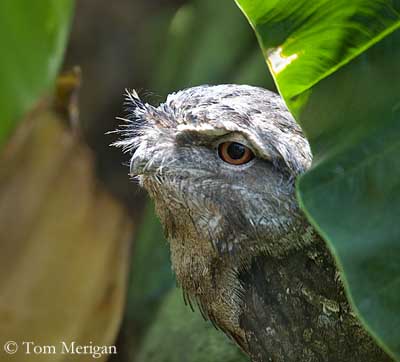
FAMILY PODARGIDAE
Frogmouths
The family Podargidae was formerly part of the order Caprimulgiformes which also includes the Caprimulgidae (Nightjars and Nighthawks), the Nyctibiidae (Potoos) and the Steatornithidae with only one member, the Oilbird.
The Podargidae are now within their own order Podargiformes. They are found from India to Vietnam, Java and Philippines, also in New Guinea and Solomon Islands to Australia and Tasmania.
Sixteen species divided into three genera make up the family Podargidae.

Text by Nicole Bouglouan
Photographers:
Roger Ahlman
Pbase Galleries Peru and Ecuador
Callie de Wet
GALLERY
Jean Michel Fenerole
Photos d’Oiseaux du monde
Steve Garvie
RAINBIRDER Photo galleries
Tom Merigan
Tom Merigan’s Photo Galleries
Otto Plantema
Trips around the world
William Price
PBase-tereksandpiper & Flickr William Price
Dubi Shapiro
Dubi Shapiro Photo Galleries
Alan & Ann Tate
AA Bird Photography
Ingo Waschkies
Bird Photography
Nicole Bouglouan
Photographic ramble
These images and the text are subject to copyright and cannot be used without express authorization from the owners. Legal issues
Sources:
HANDBOOK OF THE BIRDS OF THE WORLD Vol 5 by Josep del Hoyo-Andrew Elliott-Jordi Sargatal - Lynx Edicions - ISBN: 8487334253
NIGHTJARS - A Guide to Nightjars and Related Nightbirds – Nigel Cleere and Dave Nurney - Yale University Press - First Edition (August 11, 1998) - ISBN 10: 0300074573 / ISBN 13: 9780300074574
Nightjars and Their Allies: The Caprimulgiformes De D.T. Holyoak – Editeur : OUP Oxford, 2001 – ISBN: 0198549873, 9780198549871 – 773 pages
Fatbirder - The World’s Richest Information Resource about Birds for Birders
CREAGUS@Monterey Bay (Don Roberson)
Batrachostomus: The Mysterious World of Frogmouths
A new genus of frogmouth (Podargidae) from the Solomon Islands - results from a taxonomic review of Podargus ocellatus inexpectatus Hartert 1901
The Guardian - A new genus of frogmouth from the Solomon Islands
Oligocene divergence of frogmouth birds (Podargidae) across Wallace's Line
New Frogmouth Birds Found In Solomons
Frogmouth Symbolism & Meaning (+Totem, Spirit & Omens)
Birdlife International – Data Zone
Wikipedia, the free encyclopaedia
See also:
The bird and its nest, where everything starts…
Page 11 : Tytonidae, Strigidae, Steatornithidae, Podargidae, Nyctibiidae, Caprimulgidae
Differences between nightjars, potoos and frogmouths.
Not to mention the more scientific morphological differences which helped to separate the frogmouths from the Caprimulgiformes, their general behaviour prove that these species, while being very similar in appearance, live in different ways, in environments adapted to their needs.
The frogmouths are nocturnal birds often related to nightjars and potoos, but they are generally stockier and larger than the nightjars. They are named “frogmouths” because of their unique beak, well adapted to the large prey they consume, and quite distinct from the rather weak bill with wide gape typical of most Caprimulgiformes.
When perched on a branch, the vertical posture of the potoos makes them fairly similar to the frogmouths which are, however, stockier with a more massive beak, while on the contrary, the nightjars are often observed resting on the ground.
In fact, the beak of both nightjars and potoos, although wide and triangular at the base, is thinner, shorter and more pointed, almost hawk-like at the tip. It is sometimes barely visible in the face covered with fine, downy feathers.
If we compare these species, the beak of the frogmouths is very broad, more robust and more massive, features that completely differentiates it from the rather weak beaks with wide gape which characterize the Caprimulgiformes.
The bristles are denser and longer in frogmouths, sometimes going so far as to extend onto the ear-coverts.

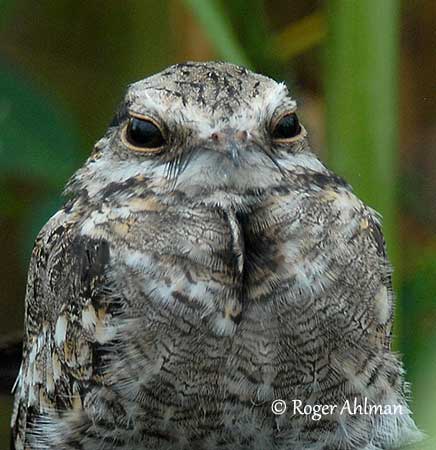
Compared to nightjars and potoos, the frogmouths hunt more actively. Once a small vertebrate or a large insect is detected from the perch, they dive onto the prey and catch it. The potoos apparently do not drop to the ground after prey, whereas the nightjars hunt mainly while flying and rarely by walking or running on the ground to catch a prey.
During the breeding season, the frogmouths build a well-formed nest placed on tree branch, whereas the potoos do not build a nest, preferring a natural depression such as a scar left on branch or trunk in a tree and without nest material. As for the nightjars, they are ground-nesting birds with the nest-sites close or among vegetation, rocks or fallen branches and logs.
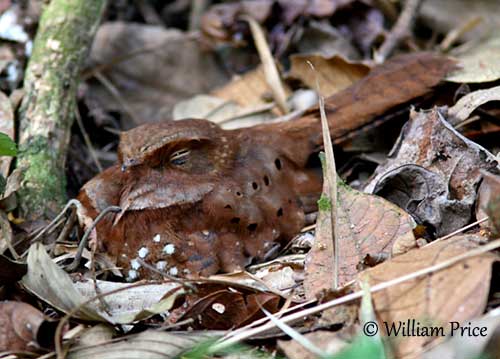
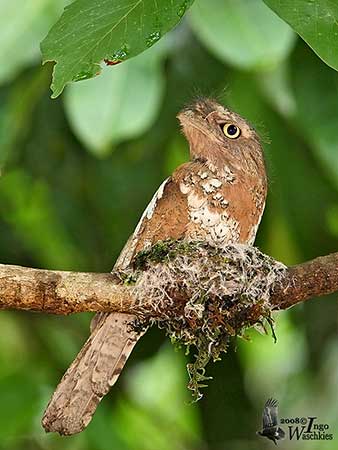
Javan
Frogmouth
We are therefore going to study the frogmouths more closely, these extraordinary birds which really deserve to be known.
The name “frogmouth” appears to be well suited to the very wide, strong, flattened, hooked bill and the large frog-like gape, both well adapted to hard-shelled prey. The facial bristles are well developed, but they vary in size among species and subspecies and can be short or fairly long.
The frogmouths are arboreal species. Their legs are very short, and both legs and feet are rather weak. The feet are mainly used for perching, although the claw of the middle toe lacks the serrated “comb” present in Caprimulgiformes. But the birds are able to walk along the branches and briefly on the ground to reach an insect.
The rounded, rather short wings and tail allow short sallying flights to pick prey from ground, trunks or foliage. But the flight of these birds is usually weak and noiseless. They can fly strongly if necessary, but the frogmouths are very sedentary, and there are no migratory species.

The plumage coloration show rather dark shades of chestnut, rufous, brown or greyish, with beautifully intricate patterning in many species. Numerous white spots, speckles and streaks are beautifully distributed throughout the plumage.
These cryptic colours, very similar to the tree branches, protect the frogmouths from predators while they are resting, roosting and nesting, both by day and at night.

Their preferred habitat is the forest where they can find thickets of trees and bushes for nesting, roosting and hunting from perches.
The frogmouths build well-formed nests, often placed on tree branches, shrubs, or on top of epiphyte, but abandoned nests by other bird species may also be used.
The nest structure differs considerably between the two genera of this family.
The family Podargidae includes three genera.
Three species are in the genus Podargus.
They are found from Australia to New Guinea.
These frogmouths have massive, broad bills, allowing them to take larger prey, especially small vertebrates. They may sometimes beat the prey against the perch or a stone, to ensure tenderness before to swallow it. But they also take large insects such as beetles and grasshoppers.

The plumage of Podargus species is heavily streaked with grey and brown vermiculations. Both pattern and plumage colour appear well-adapted to the relatively open habitats with numerous grey-barked trees where two of the three species occur. The pattern is usually streaked and creates a very cryptic plumage, providing an excellent protection when the bird is roosting on a branch.
Male and female are fairly similar in colour, but the female is often brighter than the male. The females generally have more rufous or browner coloration and less pale and dark markings.
This is probably related to the fact that the males of both genera usually incubate during the day and need more cryptic appearance protecting them from predators.

Family members roosting together
The third species, the Marbled Frogmouth, frequents lowland rainforest, and may sometimes appear very similar in coloration to Batrachostomus species.
This is especially true of females of the subspecies P.a. inexpectatus from the Solomons Islands. Their plumage is very reminiscent of that of the Large Frogmouth of SE Asia, except the white hindneck-collar of the latter species. This race is now a full species named Solomons Frogmouth (Rigidipenna inexpectata). See the description of this species below.
The Australasian Podargus are for the most part larger than the Batrachostomus, except the Large Frogmouth which may be larger than the smallest Podargus. On the other hand, the small species of Batrachostomus have no parallel in Podargus.
Some other details, such as the very special tongue of Podargus with a long, translucent, paper-like tip, make these frogmouths unique and the most curious of all the birds. There are also some differences in the tail feathers, with clearly longer central rectrices in Podargus, whereas the central pair is only slightly longer than the others and have rounder tips.

The frogmouths feed on insects and other invertebrates caught by sallying from a perch, and the largest Podargus also take small vertebrates such as frogs, lizards, small rodents and occasionally small birds. Among the more usual prey, beetles, moths, orthopterans, cicadas, bugs and many other species are taken, but other arthropods including spiders and millipedes are also part of the diet.
The Tawny Frogmouth feeds mainly by swooping to the ground from a perch to catch a prey with the beak. It often beats the large prey against the perch before to eat it. It also takes prey from the ground and usually hunts in clearings.
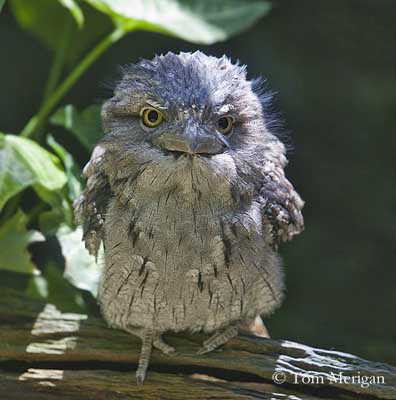
The large Podargus have songs with a mellow hooting character, sometimes becoming more booming at close range.
SOUNDS BY XENO-CANTO - Genus Podargus
The Marbled Frogmouth utters 4-7 phrases described as “coo-loo, coo-loo, coo-loo, coo-loo…” which are very different from the soft “oom-oom-oom-oom…” (10-50 phrases) given by the Tawny Frogmouth. It differs from the very low-pitched, resonant “ooom ooom ooom ooom ooom…” (9-13 phrases), given by the Papuan Frogmouth.
Both male and female sing in all three species. Songs may be given as duets by paired birds.
They sing from perches well up in trees, and mainly during the breeding season, especially for the Papuan Frogmouth.
Other calls are used in territorial defence, including loud, sharp, mechanical bill-snap or rather soft, long, moaning hoot and quick succession of short, deep “to-to-to-to-to-to-to”. The large nestlings are reported to screech if alarmed.
The genus Podargus builds a bulky to rather small platform with a shallow cup, made with criss-crossed twigs, sticks, vine tendrils or stems. There is sometimes addition of grass, leaves, moss or lichen. This structure is usually built among forking branches but also on a flat branch.

The three Podargus species are not globally threatened and are described as uncommon to locally or fairly common throughout the range. They are affected by habitat loss, especially forested habitats, for agriculture grazing and timber production, but they have a wide range. Some negative impacts also come from nest disturbance, pesticide poisoning and illegal shooting.
Twelve species are in the genus Batrachostomus.
They are found in tropical Asia.
In these species, the bill is smaller and more rounded. They are mainly insectivorous.
Both genera have strong rictal bristles around the bill base, but the members of genus Batrachostomus show longer bristles. These facial bristles probably help to direct the prey into the gape, but they may also protect the eyes from some impact with hard insects.
The Batrachostomus have an oil-gland, which is absent in Podargus.

The plumage of these species is more uniformly rufous, but some individuals, especially males, are heavily streaked. Male and female show a greater difference in coloration than Podargus. The female is mainly bright rufous with conspicuous white markings on both underparts and wings, whereas the males have mainly brown plumage with barred and streaked patterns.

In regions such as Borneo, several species of different sizes may coexist in the same habitats such as montane forests, primary lowland forests and disturbed secondary forests in the lowlands. But the members of this genus frequent mainly the dark, wet forest.
The hunting behaviour of Batrachostomus is poorly known because it is difficult to make direct observations. However, the main feeding technique consists of sallying from a perch to catch moving insects and other prey.
The small Javan frogmouth or Horsfield's Frogmouth takes the food from trunks, branches or foliage, by fluttering in front of them. This species is also suspected to catch some prey including moths and alate termites on the wing, in flycatcher-like flights.

The sounds given by the Batrachostomus are poorly known.
SOUNDS BY XENO-CANTO - Genus Batrachostomus
The smaller species give short, whistled or rather harsh songs and the main territorial call seems to be given by the female. Depending on the species, these calls are a single falling note, or a single long whistle which rises and falls in pitch, or a descending series similar to a maniacal laughter, and several others. The females tend to give loud territorial whistling, mewing, or trilling calls, whereas the males produce more plaintive sounds such as a single whistle.
But the behavioural contexts and functions of these sounds need to be more studied.
Displays and posturing of these species are very little known, but vocalisations are used to advertise and defend the territory.

The nest structure of genus Batrachostomus is poorly known, but these species seem to build a very small, neat, firm cup with interwoven down from the bird’s underparts. Some spider webs, mosses, lichens or leaves can be added on the outside, in order to make the nest invisible. It is often placed on horizontal branch in tree.
The twelve species of Batrachostomus are rare and uncommon due to deforestation, loss of lowland rainforest and fragmentation of the habitat. In this genus, six species are considered declining and Near Threatened.
A single species is in the genus Rigidipenna, the Solomons Frogmouth (Rigidipenna inexpectata).
It is found in the Solomon Islands and was first described in 1901, but it was recognized as a distinct species only in April 2007. The range in N Solomons Islands includes Bougainville, Choiseul, Santa Isabel and San Jorge, and it is also reported from Buka (N of Bougainville).
The Solomons Frogmouth was formerly considered a subspecies of the Australian Marbled Frogmouth.

The scientific name “rigipenna” is formed from the Latin words “rigidus” meaning “stiff, hard” and “penna” meaning “feather”, referring to the stiff rectrices.
The Solomons Frogmouth has only eight rectrices (usually ten or twelve in other species) with a coarser texture. This feature probably makes this species weaker in flight, by curtailing its lift potential whereas the coarser rectrices reduce the manoeuvrability.
Primary feathers and tail feathers are barred, and the plumage shows larger speckles and more conspicuous white spots.
But in addition of these details, this species shows unique differences in bone structure and a clear genetic separation from all Podargus and Batrachostomus.
The behaviour of this new species is poorly known, but it is nocturnal and arboreal like other frogmouths. It is found in primary forest and second growth, and it is occasionally seen close to gardens. It may occur from the sea-level to the foothills, but probably also well up into the mountainous areas, to at least 700 metres of elevation.
Its diet is probably similar to that of other species and includes mainly large insects.
Two vocalizations have been described:
SOUNDS BY XENO-CANTO - Genus Rigidipenna
The Solomons Frogmouth gives a series of short whistles rising in pitch and repeated at irregular intervals. Another sound is described as a series of descending whistles rapidly repeated.
A nest has been described from an observation as a shallow structure made of sticks and placed in the horizontal fork of a branch, 25 metres up in the canopy of a tall tree in secondary forest.
The Solomons Frogmouth is described as uncommon with a small population slowly declining due to continued habitat loss. But the species has been recorded in other habitat types such as secondary, degraded and altered habitats. It is currently classified as Near Threatened and has a restricted range.
The behaviour of the frogmouths is poorly understood, due to the difficulties of observing these secretive birds.
All data on these species show that they live in sizeable territories which they advertise and defend with threat calls and songs.
The frogmouths are monogamous. Both adults build the nest and share the nesting duties. The clutch includes 1-2 eggs and both mates incubate, the male by day and the female at night, during about 30 days. They also feed the chicks at nest, and the young are still fed by their parents for one or two weeks, after leaving the nest about a month after hatching. They remain in family group during several months.

Chick on the foreground
The members of the pairs often roost together, sometimes very close to each other. They usually roost on stumps or branches of trees, sometimes in thickets.
However, the Marbled Frogmouth is often reported to roost solitary, and both the Marbled Frogmouth and the Large Frogmouth are reported to roost in tree holes during the daytime.

When disturbed by an intruder, the bird remains motionless with the body held at an angle above the perch, the head is erected and the plumage sleeked. The eyes are almost closed, leaving just a narrow slit. This freezing posture and the cryptic plumage make the bird almost invisible. A very close approach by intruders may result in a prolonged gaping threat display directed at them.
The frogmouths of genus Podargus approached when perched do not adopt this posture but prefer fly away if the observer comes too close.

The frogmouths are all threatened by habitat loss, and are described as uncommon or even rare birds.
The regions of both Australia and Southeast Asia are home to many exotic species, but the frogmouths particularly arouse the curiosity of humans. These mysterious and weird nocturnal birds are often considered the strangest and most wonderful creatures of these regions.
Without being rare, they are very difficult to find and therefore observe them to get to know them better. Their very cryptic plumage and their secretive behaviour make them interesting birds, and of course, we want to know more about them!

Frogmouths are often related to mystery with their strange appearance and their nocturnal behaviour, making them creatures of the shadows.
In some Aboriginal cultures, when the call of the Tawny Frogmouth is heard after dark, it is believed that someone must die. For the cultures that feared this call, the frogmouth was magical and able to transform into wood, but also to communicate with the spirits.

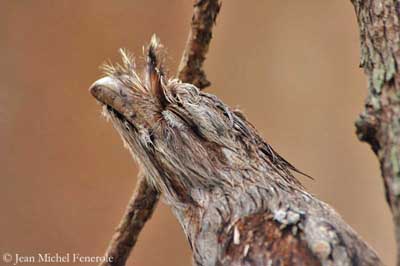
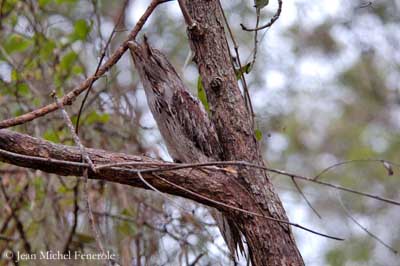
Although they are birds of the shadows, you should not be afraid of frogmouths. Moreover, many humans love them and find them beautiful.
The frogmouth’s cultural impact is limited to the indigenous peoples of Australia and Southeast Asia where this bird is considered powerful and significant.
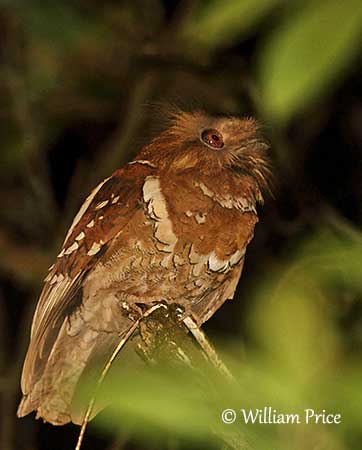

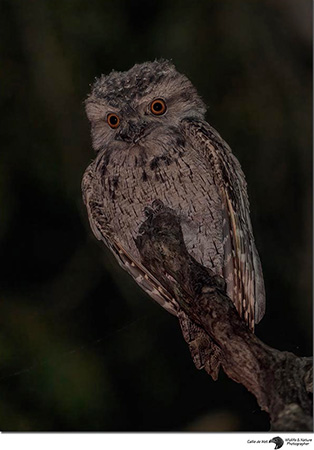
On the nest
The potoos do not build a nest. They use a natural depression on a branch in tree, often a scar left by a fallen broken branch, or at top of broken stub. A hollow without additional nest material is used for the egg.
